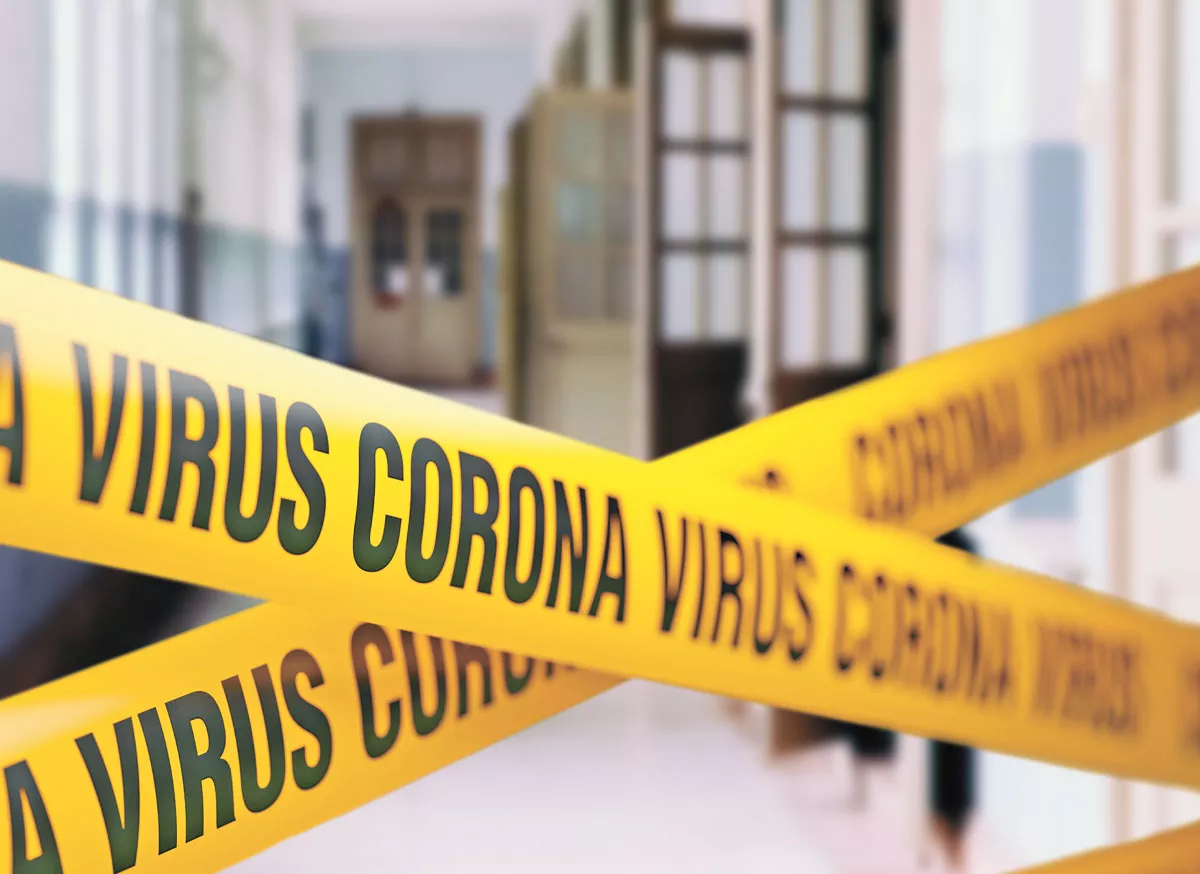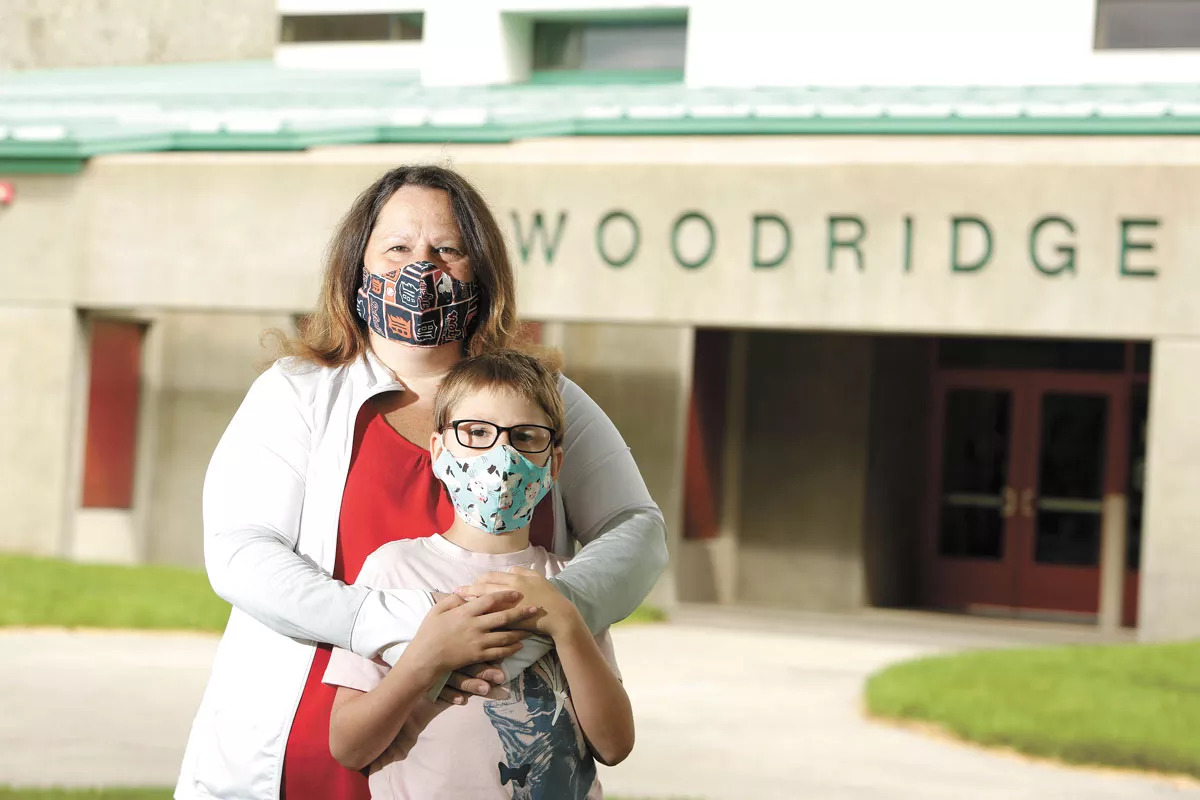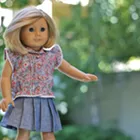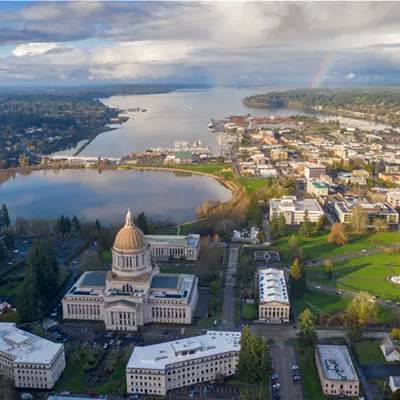The question has no right answer. The test is rigged. If Julie Ancona-Shepard sends her son to school this fall, she risks him carrying home a virus that's already killed more than 150,000 Americans. If she keeps him home, he'll fall further behind and may never catch up.
Ancona-Shepard takes COVID-19 seriously. She's hardly left the house for five months, and she follows all the rules that public health officials hope can slow the pandemic. But her son is 7 years old, legally blind and on the autism spectrum. A face on a computer screen can't teach him. Since his school, Woodridge Elementary, closed its building in the spring, Ancona-Shepard's noticed regression in her son's speech and social behavior — uncharacteristic outbursts of anger because he's frustrated that he's stuck at home and can't go back to school.
While Spokane Public Schools announced last week that it would start school online, Ancona-Shepard's son may be part of a small group of students with disabilities able to go back.
Is it worth the risk?
"It's not an easy decision for me," Ancona-Shepard says. "But if I don't do anything for him, he's going to lose a year of education being in a virtual setting."
Because of America's failed efforts to contain SARS-CoV-2 — the coronavirus causing the COVID-19 disease — parents, educators and state governments are left with an impossible choice. Opening school for in-person instruction could fuel outbreaks, sicken educators and ravage communities with preventable death.
Yet, the consequences of not opening school buildings remain grim, education and health experts say. Children may experience worsening behavioral health and will likely fall behind in school. Parents will have to stay home from work to help their kids, unable to find child care. And research suggests continued distance learning will accentuate the inequalities in education already hindering students who come from low-income families, who are Black, Hispanic or Native, or who have disabilities.
Without strong federal guidance, the difficult decision is left to states and local school districts. In Washington, the largest school systems in Seattle and Spokane chose to start the school year online before Gov. Jay Inslee encouraged other schools to follow suit. Coeur d'Alene Public Schools, meanwhile, plans to open school buildings even as the area's case counts per capita have leapfrogged Spokane's just across the border. Idaho Gov. Brad Little, like President Trump, has pushed schools to open for in-person instruction.
Both options threaten to punish the most vulnerable.
"We certainly saw some kids whose learning losses were minimal. And then we saw many, many other children whose entire lives were disrupted by the pandemic."
tweet this
THE DANGER OF DISTANCE LEARNING
In June, when COVID-19 cases in Washington and Idaho seemed manageable for public health officials, states urged schools to plan on opening buildings in the fall with proper safety measures.
"I think today is a moment of hope," said Chris Reykdal, Washington's superintendent of public instruction, as he released a framework for schools to open in the fall.
Washington schools prepared plans for two scenarios: One in which opening in-person was possible, and one where it was not. As summer came, however, cases in both Idaho and Washington ballooned. The day Reykdal made his announcement, June 11, Spokane County had 791 confirmed COVID-19 cases. Then, Spokane County added quadruple that amount over the span of roughly six weeks. By Aug. 3, Spokane Public Schools announced it would begin the school year remotely, following guidance of health officials. Neighboring Central Valley School District announced similar plans the same day.
But even if distance learning is better than it was in the spring, can it replace in-person instruction?
Experts doubt it.
"It's absolutely not comparable. Not at all. Especially for those children who don't come from a place of privilege," says Tara Haskins, education department chair at Eastern Washington University. "I wonder what the long-term effects from this will be."
Her guess: The rich get richer and the poor get poorer. The gap between those who have resources and those who don't widens. Racial disparities in student achievement worsen.
Distance learning in the spring was largely a fiasco. In March, teachers said goodbye to their students not knowing how long the school shutdown would last. They weren't equipped to transition quickly into online education, and the menu of digital platforms led to an inconsistent delivery of online learning that confused families. Many students didn't engage in online learning at all, and it took valiant efforts from counselors to even find some students who became otherwise invisible outside of the school building.
The entire experience was defined by inconsistency. For each school district that could provide laptops to all students, another could not. For each teacher who diligently checked in on students, another did not. For each parent able to help kids with school work, another could not.
"We certainly saw some kids whose learning losses were minimal," says Kate Orozco, assistant superintendent of elementary education and instruction for Coeur d'Alene Public Schools. "And then we saw many, many other children whose entire lives were disrupted by the pandemic."
Some research suggests that the learning lost in spring already might cause long-term damage. Following a 2005 earthquake in Pakistan, one study found that children who missed three months of school were a year and a half behind in their learning, compared to where they should normally have been. Modelers with the Research on Improving Systems of Education Programme (RISE) predict similar losses from the spring COVID-19 shutdown.
School districts hope distance learning in the fall won't be as chaotic as in the spring. In Spokane Public Schools, it will be a "real-time" school day, with a school start and dismissal time. Classes will all use one uniform digital platform, Microsoft Teams. Lanya McKittrick, a research analyst at the Center on Reinventing Public Education, says she's encouraged when she sees school districts, not just in Spokane but in larger systems like Sacramento City Unified School District, release similar plans that spell out what the day will look like, how attendance will be taken, what the family's role will be.
"That feels different than what was happening in the spring," McKittrick says.
But even the most organized online programs can't replace in-person instruction, research suggests. In 2015, Stanford's Center for Research on Education Outcomes concluded that academic benefits from online schools are "currently the exception rather than the rule," with one of the authors at the time saying that the gains online students saw in math were so minimal that it was "literally as though the student did not go to school for the entire year." In both Idaho and Washington, online schools drag down graduation rates. Some of this can be explained by the fact that online schools tend to enroll students who were struggling in traditional settings in the first place, but there's little evidence that online programs are more effective as remediation. In a 2015 study, students who failed an algebra course still did better in an in-person credit-recovery program than an online one.
Teachers in physical classrooms didn't sign up to be online instructors. There can be a steep learning curve as they attempt to transition to full distance learning in the fall.
"There's no great solution. There isn't this mystery solution sitting out there that we haven't thought of."
tweet this
Jeremy Shay, president of the Spokane Education Association that represents local educators, says there are plenty of logistical questions still being worked out. How much of the daily schedule will rely on the help of parents who may not have the ability to do so? How do you manage a class of first graders virtually, and what happens when one simply walks away from the computer? What if students don't have an internet connection strong enough for a video call?
Starting in a remote learning environment — which many Spokane teachers still support — means these questions may be unanswerable.
"There's no great solution," Shay says. "There isn't this mystery solution sitting out there that we haven't thought of."
The consequences of continued online learning go far beyond academics, however. School is not just a place where students can come and learn reading, math and science. It's where they learn social skills, and it may be one of the few places where they feel safe and can rely on a meal. It also serves as child care for working parents.
The public health risks of opening school may be more immediate, but not having school has its own public health consequences.
"We know, for example, if you do not graduate from high school, your economic achievement is significantly impacted," says Spokane health officer Bob Lutz. "And we know that individuals who have lower educational attainment have poor health outcomes — physical, mental and behavioral health outcomes."
It's a loop that perpetuates poverty and racial inequality. Students in low-income families — disproportionately students of color — are less likely to achieve educational goals, which in turn makes them more likely to be low-income. An article in June published by the consultant firm McKinsey & Company found that low-income, Black and Hispanic students will experience the most learning loss due to the pandemic, falling behind in academics by up to a year and likely leading to higher drop-out rates. The health and economic devastation of the pandemic causes trauma and stress for kids as well, and that only compounds students' struggles.
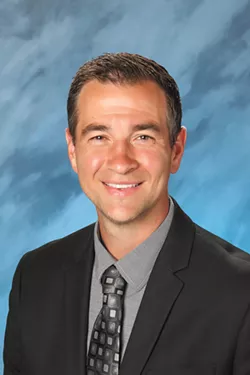
Spokane Public Schools superintendent Adam Swinyard has repeated that he and the Spokane community are "grieving" over starting the school year online.
"I think it will be some time before we fully understand the impact of this experience for our students. We know when students aren't engaged, when they don't have the opportunity to meet essential learning standards that are going to prepare them for secondary experiences, there's a detrimental impact on their trajectory," Swinyard tells the Inlander. "We know this experience is going to, in many ways, exacerbate that."
Brianna Rollins, a single working mom with two young children in Spokane, says online school in the spring already took a toll on her kids. She has little capacity to help them with school work, and she knows her kids might fall further behind in the fall.
"I can't be a mom and be a cook and be a maid and be a teacher and be a worker," she says.
But the alternative? For Rollins, that's an even worse option. Remote learning is temporary. The consequences of getting COVID-19 may not be.
"I'd rather my kids were safe and healthy, and didn't expose other families if they catch coronavirus," Rollins says.
THE DANGER OF IN-PERSON LEARNING
On the same day Spokane Public Schools decided to scrap its plan to open in-person because of rising infection rates, Coeur d'Alene Public Schools, roughly 35 miles away, went the opposite direction. It would open school buildings for in-person classes, even as cases per capita rose faster than in Spokane.
"We know our community has very strong feelings about starting in-person, to whatever extent we can, and we support that," says Orozco, the assistant superintendent. "Except never for at the expense of the safety of kids or adults. Never then."
The problem is, there's no clear direction on what's a safe way to open schools.
"It's a natural experiment," Lutz says.
Other countries have opened schools, though typically the community spread at the time has been lower than in the U.S. When Israel reopened its schools, thinking it too had the virus under control, it saw infection rates explode. Without clear federal guidance — not counting President Trump encouraging school reopenings while falsely claiming children are "almost immune" to COVID-19 — the decision is left to state and local health officials, or schools themselves.
"You look at the guidance, and the CDC guidance is meaningless," Lutz tells the Inlander. "It said, 'Open up schools but be cautious.' Well, thanks. Thanks. Every state is coming up with its own metrics, its own way of doing things. We've got 50 states doing 50 different things."
If opening schools is indeed an experiment, Coeur d'Alene Public Schools looks ready to let it play out. Thinking infection rates would be down by the fall, the school district surveyed students, parents and staff, asking which safety measures they would support when school opens up. The survey never asked how parents felt about starting school remotely. CDA Schools spokesman Scott Maben says that question wasn't asked because "when we were conceiving this, it didn't seem like that was going to be a reality for us."
The plan has four different risk levels that would dictate safety measures, from minimal risk, where buildings open with "social distancing as is practical" and no mask requirement, to critical risk, where buildings are closed. With help from Panhandle Health District, Coeur d'Alene Public Schools determined it was in the "moderate" risk category, which meant buildings would be open and masks would be required.
Lutz questions what "moderate" risk means, noting Kootenai County's incidence rates, or case counts per capita, were rising higher than Spokane's. Indeed, the difference between risk categories in North Idaho appears open to interpretation. "Widespread" or "sustained" transmission would fall under the Panhandle Health's moderate category, while "large-scale" transmission would fall under the highest risk category. But Panhandle Health wouldn't share with the Inlander case counts, hospitalizations or any other metrics that would define what is "widespread" vs. "large-scale" transmission.
"It's a very different dynamic when you cross 30 miles over the border," Lutz says.
By contrast, Washington's guidance has three different risk categories defined by case rates. Low-risk counties, for example, would have fewer than 25 new cases per 100,00 residents over two weeks. Those counties — of which there are few currently — are encouraged to have a mix of in-person learning and distance learning. The state "strongly recommends" that high-risk counties, a category Spokane easily falls under, start with distance learning only.
Opening up with high infection rates, however, isn't just an Idaho thing. Mead School District, just north of Spokane Public Schools, decided last week it would flout local and state health recommendations and open in-person instruction for grades K-5 and then have a rotating schedule for older students.
The science isn't settled on how kids, especially young children, transmit COVID-19 compared to adults. Children account for a small proportion of cases across the country, and early indications suggested they may not transmit the virus as easily. More recent research, however, suggests the opposite. A study published weeks ago in JAMA Pediatrics found that children under the age of 5 carry just as much or more coronavirus in their noses and throats than older people, even if children don't feel as sick. In an overnight camp in Georgia, hundreds of kids got infected, the CDC reported, suggesting that the virus can spread indiscriminately in congregated settings no matter the age of the group.
It's unclear what would happen in a school setting with safety measures in place. But in recommending that schools start online, Lutz went back to what he knows: Social distancing works. It held back COVID-19 in the spring, allowing for hospitals to gather resources even if it didn't eradicate the threat completely. Then when things opened up, the virus seized the chance to spread again.
Shay, the Spokane Education Association president, worries that schools in Mead and North Idaho will fuel the spread of the virus across the Inland Northwest. That would further delay any school building reopening plans.
"In making the decision to go to distance learning, what we're really trying to do is prevent the spread — anything we can do to prevent the spread," he says. "I think a lot of our work will be undone if other communities go in-person."
Just as there are racial disparities in who will suffer without school, so too are their racial disparities in who's most at risk in a COVID-19 outbreak. People of color account for a disproportionate number of COVID-19 deaths in the U.S., and children are neither immune to the virus nor the disparate racial impacts. Research released by the CDC last week indicates that Hispanic children were hospitalized at a rate eight times higher than White children. Black children were hospitalized five times more often.
While children are typically spared the severe symptoms associated with COVID-19, there are teachers, administrators, custodial staff and other adults in school buildings who they might unintentionally infect. Plus, there's the danger that kids bring the virus home.
Ancona-Shepard, the parent who wants her 7-year-old back in school, admits that's a scenario that scares her. As part of the district's special education task force on reopening schools, Ancona-Shepard says she feels strongly that it's too dangerous for schools to open for all students in-person right now.
"My kids get me sick all the time," she says. "Schools are like petri dishes. There's no way to have all kids there with nothing in place — that would just be nuts."
By now, the consequences of a major outbreak are well established. We've already seen it: Preventable death, long-term health impacts for survivors, more school closures and economic collapse.
Lutz knows the decision to reopen schools isn't solely about stopping the pandemic. If it was, he says it would be an "easy decision" to close schools. But it's not. The decision must also consider the well-being of kids, families and the community, along with the lasting mental and physical health impacts. Lutz says it took a week of sleepless nights before he and the health district ultimately decided to recommend that school buildings stay closed.
"Public health weighs the weight of these decisions. It's not all about COVID-19. We definitely understand the big picture and the long view," he says. "But we're still in a pandemic. We have not exited the pandemic. And we have to ask for patience."
"I think we'll look at this moment decades from now and we'll see this as a turning point in public education."
tweet this
THE OPPORTUNITY
The pandemic didn't create the inequalities that currently exist in education, where students living in poverty — more often Hispanic, Native and Black students — face greater barriers to achieving school success than more affluent, typically White counterparts. It didn't create the disparities in internet and computer access, the lack of resources for students with disabilities. Nor is the pandemic-driven school shutdown in spring responsible for the uneven delivery of online education.
These problems existed long before COVID-19, each one a steady current feeding into a sea of larger social, economic and health inequities.
"This has always been going on," says Vanessa Anthony-Stevens, a University of Idaho assistant professor who researches diversity and equity in education. "We know our system already contributes to vast inequities."
Then the pandemic came in like a storm, flooding those currents and making them impossible to ignore.
Rarely have those inequities been this visible. Teachers, for instance, may know that the success of their students relies on more than what happens in the classroom. But classrooms, Anthony-Stevens says, can perpetuate an illusion that teachers are delivering an equal education to everyone as long as they're in a controlled environment, as if the physical space is the equalizer.
"It's forcing teachers to recognize that our infrastructure is not decontextualized from larger social inequities," Anthony-Stevens says.
That can present an opportunity. It's the one glimmer of hope education researchers like her and school leaders cling to: If the pandemic wiped out the school system as we know it, maybe it can be rebuilt more equitably.
"I think we'll look at this moment decades from now and we'll see this as a turning point in public education," says Swinyard, who took over as Spokane Public Schools superintendent this summer.
Whether they're offering in-person instruction this fall or not, school systems had to develop new ways to deliver instruction. Out of necessity, school districts have engaged students in their homes "in ways we never imagined were possible," says Orozco, with Coeur d'Alene Public Schools. Schools will be more mindful in developing relationships with parents, and more open-minded and flexible with students.
"We are learning some profound lessons about how to take an educational system that has been historically resistant to change, showing a mirror to ourselves and saying, 'There are much better ways to serve our kids,'" Orozco says. "And we're doing it."
Schools can rethink education and match the funding and material resources to meet those needs, Anthony-Stevens says. They can reevaluate which students need to be at school, and which would benefit away from it, leveraging technology. Teachers can become more attentive to student needs away from home, understanding the family situations shaping a student's perceptions. In her view, it's a chance to move away from a standardized world and toward a model that provides more meaningful learning that students can use in their own world. She argues school districts should have more autonomy to support each individual student, and that a greater emphasis on providing access to technology and resources should only strengthen that effort.
"Online learning and diversifying delivery of information are good things. They offer more possibilities for a diverse society, to do it in ways that build on student strengths," she says.
Distance learning probably shouldn't be the default, but Swinyard, too, sees a greater role for it moving forward. He says it's a trajectory moving away from "one size fits all." Because of the shutdown, teachers have invested time in understanding how it can work effectively and that can be a "powerful asset when deployed correctly," Swinyard says.
Those changes, however, represent the most optimistic view of how schools may change, Anthony-Stevens says.
The more realistic picture? That's uglier.
It would go the opposite way: As state budgets reel from the pandemic, politicians defund public schools, stripping school districts of the needed infrastructure to address inequities. The economy crumbles, forcing more families into poverty. As children need more support, schools become less equipped to give it to them.
"Schools are going to open, and it is poor people who are going to suffer," she says. "We already see that in every way across our society."
The most crucial question, then, isn't when kids will see school buildings again. It's whether the system will turn a blind eye to these students once they do.
"We can't meet the needs of this generation," says Anthony-Stevens, "without seeing them." ♦

